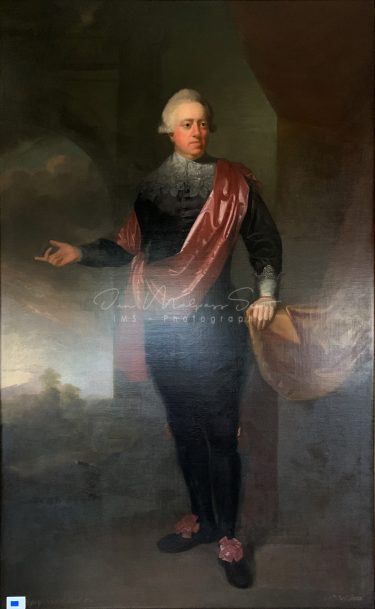![]()
Oil on canvas of John Delaval by William Bell in Seaton Deleval Hall, Northumberland.
One of a set of 6 painted for John Hussey Deleval (1728-1808) that hung in the central hall by Bell. Painted in 1775.
John Hussey Delaval, 1st Baron Delaval (17 March 1728 – 17 May 1808), known as Sir John Delaval, Bt, between 1761 and 1783, was an English landowner and politician.
Delaval was the son of Francis Blake Delaval, who inherited estates at Ford Castle, Northumberland from his mother Mary, née Blake, and at Seaton Delaval, Northumberland from his uncle Admiral George Delaval (1660–1723). John’s mother was Rhoda Apreece, through whom John inherited Doddington Hall, Lincolnshire. He was educated at Westminster School and Pembroke College, Cambridge. Delaval bought his father’s estates from his elder brother Sir Francis Blake Delaval (1727–1771) in exchange for an annuity, and developed the farming resources at Ford and the coal and mineral resources at Seaton.
His sister was Rhoda Delaval, an artist and wife of Edward Astley.
Delaval served as Member of Parliament for Berwick on Tweed 1754–1761, 1765–1774 and 1780–1786. He was created a baronet, of Seaton Delaval in the County of Northumberland, in the Baronetage of Great Britain in 1761, and in 1783 he was raised to the Peerage of Ireland as Baron Delaval, of Redford in the County of Wicklow.[5] In 1786 he was further honoured when he was made Baron Delaval, of Seaton Delaval in the County of Northumberland, in the Peerage of Great Britain.
Delaval’s seat was at Seaton Delaval Hall, an 18th-century masterpiece by Sir John Vanbrugh. Lord Delaval gave artist William Bell his patronage, in return for a series of portraits painted of him and his family, and two views of Seaton Delaval Hall.
Delaval married twice but his only son predeceased him aged just 19, and the baronetcy and baronies became extinct on his death in 1808. He was buried in St Paul’s Chapel, Westminster Abbey.
He left his second wife Susannah Elizabeth a life interest in the Ford estate, after which it was to pass to his granddaughter Susan, and bequeathed his estates of Seaton Delaval and Doddington to his brother Edward Hussey Delaval (1729-1814). On the death of Edward in 1814, Doddington passed to Edward’s wife and then to his daughter Sarah. Seaton Delaval passed to Jacob, the son of his deceased sister Rhoda, who had been married to Sir Edward Astley of Melton Constable in Norfolk.
William Bell (1734/5 – 1794) was an English painter who specialised in portraits. A prize-winning student at the Royal Academy of Arts, influenced by Sir Joshua Reynolds, he achieved eminence in his native area, the North East of England. His best-known works are portraits of Sir John (later Lord) Delaval and his family, which are in the collection of the National Trust at Seaton Delaval Hall, Northumberland. Bell’s portrait of Robert Harrison, 1715–1802, is in the collection of the National Portrait Gallery, London.
![]()


